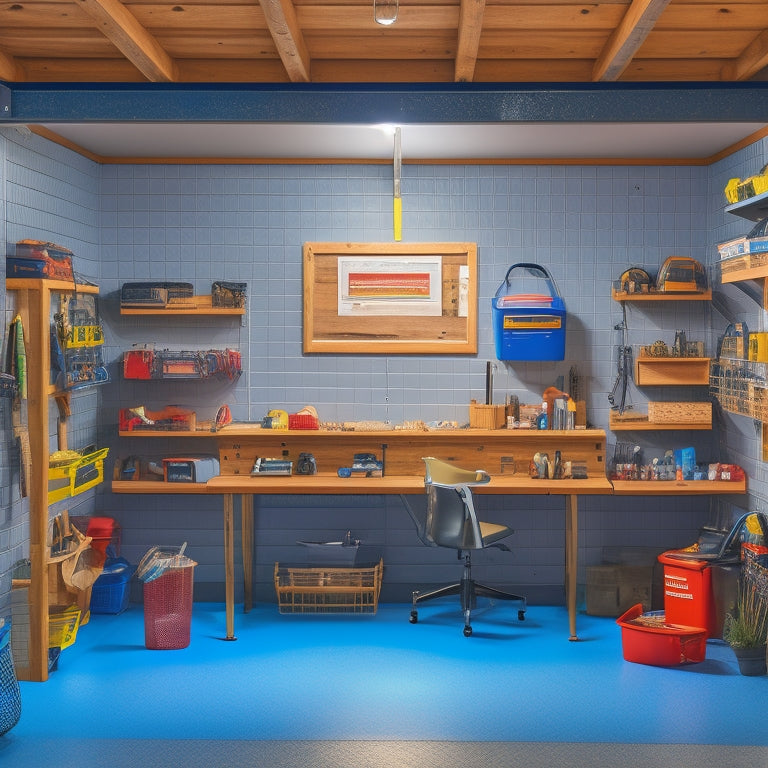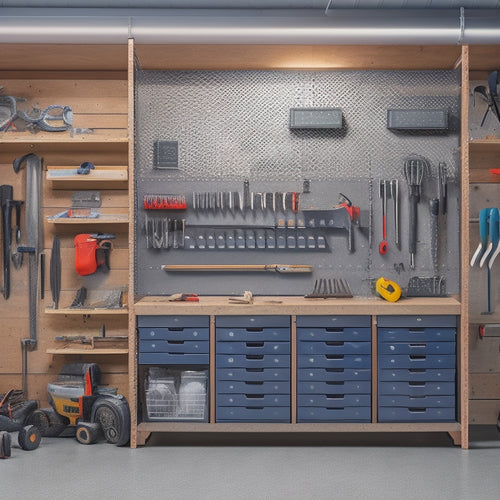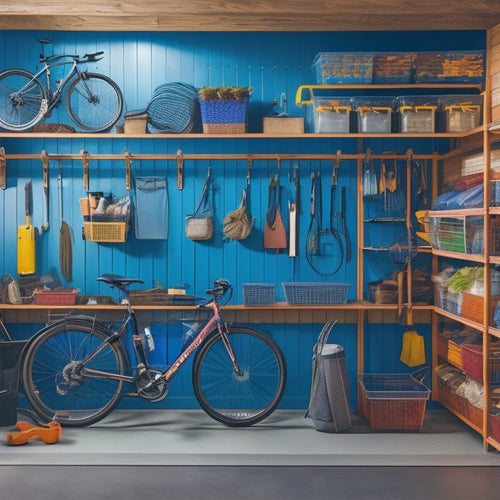
Budget-Friendly Ideas for Organizing Your Garage Workspace
Share
You can alter your cluttered garage into a functional workspace without breaking the bank. Repurpose old furniture into unique seating, work surfaces, or storage units. Employ vertical space by installing overhead shelves and wall-mounted hooks for hanging tools and accessories. Create zones for tasks like tool preparation, material storage, and assembly to increase efficiency. Label and sign everything for easy identification and access. With adjustable shelving, maximize corner space, and hang tools and accessories to free up floor space. By implementing these budget-friendly ideas, you'll be well on your way to creating a functional and organized garage workspace - and there's even more to uncover.
Key Takeaways
- Repurpose old furniture to create unique seating, work surfaces, and storage units, reducing waste and saving money.
- Incorporate DIY storage bins made from durable materials like sturdy plastics, metals, or fabrics to maximize space efficiency.
- Utilize vertical space by installing overhead shelves, wall-mounted hooks, and multi-functional storage units to keep the workspace clutter-free.
- Create zones for tasks, such as tool preparation, material storage, and assembly areas, to increase efficiency and reduce clutter.
- Implement a labeling system using color coding, clear containers, and descriptive labels to easily identify and access items, reducing searching time.
Repurpose Old Furniture
Since you're setting up a garage workspace, you likely have some old furniture lying around that can be repurposed to save money and reduce waste.
Consider upcycling old stools to create unique seating areas or additional work surfaces. Vintage cabinets can be refinished and repurposed as storage units for tools and supplies. You can also breathe new life into old desks by reimagining them as workbenches or adding new hardware to create a functional workstation.
Don't overlook old shelves, which can be easily repurposed to store items like bins, baskets, or even machinery.
With a few furniture hacks, you can alter old pieces into functional and safe workstations. For example, you can add casters to an old bench to create a mobile workstation or attach a vice to an old desk to create a secure holding area.
If you don't have old furniture lying around, consider thrifted finds or reclaimed wood to create unique and functional pieces.
Utilize Vertical Space
You'll be amazed at how much storage you can squeeze into your garage workspace by utilizing vertical space.
By maximizing storage capacity, you'll keep your workspace clutter-free and organized, allowing you to focus on your projects.
Install overhead shelves to store infrequently used items, freeing up floor space for your most essential tools and equipment.
Maximize Storage Capacity
Take a step back and assess your garage workspace - chances are, you're wasting a significant amount of space by not employing your walls and ceiling.
By maximizing your storage capacity, you'll free up floor space and create a safer, more efficient workspace.
To get started, consider the following space-saving techniques:
- Install wall-mounted hooks for hanging tools, bikes, or accessories, keeping them organized and out of the way.
- Employ multi-functional storage units like pegboards with bins and hooks to store small items and keep frequently used tools within easy reach.
- Add a slatwall with baskets and bins to store items like sports equipment, cleaning supplies, or seasonal decorations.
- Incorporate stackable storage bins and shelving units to store items like paint cans, cleaning supplies, or other garage essentials.
Install Overhead Shelves
Your garage's vertical space is a rich source of untapped storage potential. Installing overhead shelves is an excellent way to employ this space, keeping your frequently used items within easy reach while freeing up floor space for more important tasks.
When selecting shelf materials, consider durable options like plywood, MDF, or metal. These can support heavy loads and withstand the garage's humid environment.
Before installation, verify you have a clear understanding of your garage's structural integrity. Check the weight capacity of your ceiling and the type of ceiling material you have. It's essential to follow proper installation tips to avoid accidents.
Start by marking the spot where you want to install the shelf, then drill pilot holes for the screws. Use wall anchors or screws specifically designed for your ceiling type to secure the shelf.
Create Zones for Tasks
You'll increase efficiency and reduce clutter by creating zones for tasks in your garage workspace.
Set up task segregation areas, where you dedicate specific sections to distinct activities, such as a workstation for woodworking and another for automotive projects.
Task Segregation Areas
A well-organized garage workspace relies heavily on task segregation areas, which involve dividing the space into distinct zones dedicated to specific tasks or activities. By doing so, you'll be able to prioritize tasks more efficiently, optimize your workflow, and reduce the risk of accidents.
This approach allows you to focus on one task at a time, reducing distractions and increasing productivity.
Some examples of task segregation areas you can create in your garage workspace include:
-
Tool preparation zone: Designate a specific area for preparing tools and equipment, such as a workbench or a pegboard, to keep them organized and within reach.
-
Material storage zone: Allocate a zone for storing materials, like lumber, paint, or other supplies, to keep them organized and easily accessible.
-
Assembly zone: Create a zone for assembling projects, with a clean and clear surface, to minimize clutter and guarantee accuracy.
- Cleaning and maintenance zone: Designate a zone for cleaning and maintaining equipment, with access to necessary cleaning supplies and tools.
Workstation Clustering Zones
By dividing your garage workspace into task segregation areas, you've taken the first step in maximizing efficiency.
Now, it's time to create workstation clustering zones within each area to optimize zone efficiency. This involves grouping similar tasks or tools together to reduce walking distances and improve workspace ergonomics.
Identify the tasks you perform most frequently and group them into zones. For example, create a zone for woodworking, another for automotive repairs, and a third for storage.
Within each zone, organize your tools and equipment in a way that minimizes movement and maximizes productivity.
Keep frequently used items within easy reach to reduce strain and fatigue. Consider installing shelves, hooks, or bins to keep items off the floor and make the most of your vertical space.
Label and Sign Everything
Clarity is the hallmark of a well-organized garage workspace, and labeling and signing everything plays an essential role in achieving it. When you label and sign everything, you create an environment where everything has its designated place, making it easy to find what you need quickly and efficiently. This not only saves you time but also reduces frustration and potential safety hazards.
To achieve this, consider the following ideas:
-
Use color coding to categorize similar items, such as tools or materials, and label them accordingly. This creates a visual hierarchy and makes it easy to recognize what's inside a container or on a shelf.
-
Choose clear containers that are easy to label, allowing you to see the contents without having to open them.
-
Invest in a label maker that can produce customizable labels, and place them strategically on shelves, bins, and containers.
- Position signs in strategic locations, such as above workstations or near frequently used items, to create an organizational theme that reinforces your functional aesthetics.
Install Adjustable Shelving
You've optimized your garage workspace with labeled and signed containers, but now it's time to take organization to the next level by installing adjustable shelving. This will provide you with the flexibility to store items of varying sizes and create a more efficient use of space. Adjustable shelving offers several benefits, including:
| Adjustable Shelf Benefits | Description |
|---|---|
| Customizable Storage | Store items of different sizes and adjust shelves as needed |
| Maximized Space | Make the most of your garage's vertical space |
| Easy Access | Reach items without straining or using ladders |
| Durability | Adjustable shelves are built to last and withstand heavy loads |
When installing adjustable shelving, keep the following tips in mind:
- Choose shelves that are sturdy and can hold the weight of your items
- Measure your garage space carefully to guarantee a proper fit
- Consider installing shelves with built-in hooks or bins for added storage
- Follow the manufacturer's instructions for installation to guarantee safety and stability
Incorporate DIY Storage Bins
You'll want to choose the right materials for your DIY storage bins, considering factors like durability, moisture resistance, and ease of cleaning.
Once you've built your bins, labeling them clearly will guarantee you can quickly find what you need, saving you time and frustration.
When deciding on the size of your bins, think about the items you'll be storing and the space available in your garage, so you can maximize your storage capacity.
Bin Materials Matter
Three essential factors to contemplate when creating DIY storage bins for your garage workspace are the materials you'll use, the size and shape of the bins, and the way you'll label them.
When it comes to materials, you'll want to choose options that guarantee bin durability and bin aesthetics. Consider using sturdy plastics, metals, or durable fabrics that can withstand the garage environment.
Avoid flimsy or brittle materials that may break or crack under the weight of your tools or supplies.
Some materials you might consider include:
- Plastic containers with reinforced handles
- Metal bins with rust-resistant coatings
- Sturdy canvas or nylon storage bins
- Reclaimed wood crates for a rustic touch
Remember to select materials that fit your needs, budget, and personal style. By choosing the right materials, you can create DIY storage bins that are both functional and visually appealing.
Labeling for Easy Access
With your DIY storage bins constructed from durable materials, it's time to make certain they're easily accessible by incorporating a clear labeling system. This will enable you to quickly identify what's inside each bin, saving you time and reducing frustration.
Invest in a label maker to create clear, readable labels that can withstand the garage environment. Consider using color coding to categorize your bins, such as using red labels for tools, blue for automotive supplies, and green for gardening equipment. This visual system will help you locate what you need at a glance.
Additionally, use descriptive labels that indicate the contents of each bin, such as "Socket Set" or "Air Compressor Accessories." This will prevent you from having to dig through multiple bins to find what you need.
Size Matters Too
Constructing DIY storage bins in various sizes is crucial for maximizing garage workspace organization.
You'll want to take into account your workspace dimensions and garage layout when deciding on the sizes of your bins. This will guarantee that they fit snugly in their designated areas, making the most of your available space.
To get started, think about the types of items you'll be storing and the frequency of use.
You may need:
- Small bins for often-used items like screws, nuts, and bolts
- Medium bins for less frequently used items like seasonal decorations or out-of-season clothing
- Large bins for infrequently used items like camping gear or luggage
- Extra-large bins for bulky items like lawn equipment or toolboxes
Maximize Corner Space
In the often-wasted corner spaces of your garage, opportunities abound for clever storage solutions. By maximizing these areas, you'll create a more efficient workspace and reduce clutter.
Consider installing corner shelving to store items like bins, baskets, or even a small refrigerator. This will help keep your workspace clear and provide easy access to frequently used items.
| Corner Space Solution | Benefits |
|---|---|
| Corner Shelving | Stores items off the floor, keeping the workspace clear |
| Corner Workbench | Provides additional workspace and storage for tools |
| Pegboard | Allows for customizable storage and easy access to tools |
| Corner Cabinet | Secures important items and keeps them out of sight |
| Sliding Storage | Offers easy access to items while keeping the floor clear |
Remember to measure your corner spaces carefully before purchasing any storage solutions to guarantee a perfect fit. With a little creativity, you can turn these often-wasted areas into significant storage and workspace assets.
Hang Tools and Accessories
Hanging tools and accessories from the ceiling or walls is an excellent way to free up floor and bench space, keeping your garage workspace organized and clutter-free.
By doing so, you'll create a safer environment with reduced tripping hazards and more room to move around. Plus, you'll improve tool visibility and accessory accessibility, making it easier to find what you need when you need it.
Some ideas for hanging tools and accessories include:
- Installing pegboards or slatwalls to hang frequently used tools, such as hammers, screwdrivers, and pliers
- Using overhead storage racks to hold infrequently used items, like seasonal decorations or out-of-season sports equipment
- Mounting bins and baskets to store small parts and accessories, like nuts, bolts, and screws
- Suspending bicycles, lawn equipment, or other bulky items from the ceiling to free up floor space
Designate a Workspace Area
With a clutter-free garage workspace, you're now ready to designate a specific area for your projects. This dedicated workspace will help you stay focused and efficient, guaranteeing you can tackle tasks safely and effectively.
When designing your workspace layout, consider ergonomic considerations to minimize fatigue and discomfort. Position your work surface at a comfortable height, allowing you to stand or sit with good posture.
Ascertain adequate lighting, either by installing task lighting or positioning the workspace near a natural light source.
Consider the type of projects you'll be working on and allocate space accordingly. For example, if you'll be working with large or heavy items, designate an area with sufficient floor space and storage for associated tools and materials.
Additionally, allocate space for waste disposal and recycling to maintain a clean and organized environment.
Implement a Pegboard System
Now that you've designated a workspace area, you're ready to optimize it with a pegboard system. This will help you efficiently organize your tools and accessories, keeping them within easy reach and saving you time and frustration.
A pegboard system typically consists of a wall-mounted board with hooks, bins, and other accessories to hang and store your tools.
Here are some ideas to get you started:
- Install a pegboard on a wall or the back of a door to maximize storage space
- Choose pegboard accessories that fit your specific tool organization needs, such as bins for small parts, hooks for hanging tools, and trays for holding frequently used items
- Consider a pegboard with adjustable hooks to accommodate tools of varying sizes
- Keep your most frequently used tools at eye level for easy access, reserving higher or lower hooks for less used items
Frequently Asked Questions
Can I Organize My Garage Workspace on a Tight Deadline?
You can organize your garage workspace quickly by focusing on time-saving tips and quick solutions, like sorting items into categories, using multi-functional storage, and labeling everything, allowing you to achieve a functional space within your tight deadline.
How Do I Keep My Garage Organized With Frequent Use?
You'll maintain a clutter-free garage by implementing storage solutions like bins and hooks, and prioritizing workspace efficiency by designating zones for specific tasks, ensuring a safe and functional environment that withstands frequent use.
Are Garage Organization Systems Worth the Investment?
You'll find that garage organization systems are worth the investment if you do a cost-benefit analysis, considering the long-term savings on time, reduced risk of accidents, and increased productivity they'll bring to your frequently used garage workspace.
Can I Organize My Garage Without Professional Help?
You can definitely organize your garage without professional help by using DIY organization tips, such as categorizing items and assigning a home for each, and implementing essential storage solutions like shelving and bins to maintain a safe and clutter-free space.
How Often Should I Maintain My Garage Organization System?
You should create a maintenance schedule to guarantee your garage organization system stays on track, setting aside time each week to tidy up and implement organization tips, like categorizing and labeling, to prevent clutter from building up again.
Conclusion
As you change your garage workspace, remember that organization is the key to releasing your full potential. With these budget-friendly ideas, you'll be able to tame the chaos and free your creativity. Your newly organized space will be the canvas where your projects come to life, and with every tool in its place, you'll be the expert painter, bringing your vision to reality.
Related Posts
-

Small Storage Bins to Maximize Shelf Space
When maximizing shelf space, you want to make the most of every inch. Small storage bins are the answer, but choosing...
-

Building a Wall Tool Storage System
You're about to create a customized wall tool storage system that streamlines your workflow. Start by clearing your w...
-

Garage Wall Storage Ideas to Boost Productivity
You can enhance your garage's productivity by capitalizing on your ceiling height with overhead racks, storing bulky ...


